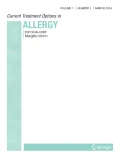Abstract
Purpose of review
Cold-induced anaphylaxis (ColdA) is a poorly understood form of anaphylaxis that occurs in patients with cold urticaria (ColdU). This comprehensive review aims to deepen the understanding of ColdA. It emphasizes the identification of high-risk ColdU patients susceptible to ColdA and provides recommendations for their effective management.
Recent findings
Recent studies, including the large international COLD-CE study, have identified clinical features of ColdU patients associated with increased ColdA risk. These individuals can now be recognized through routine clinical assessments.
Key diagnostic indicators for assessing ColdU and the risk of ColdA include oropharyngeal/laryngeal symptoms and positive standard local cold provocation tests. ColdA has been defined as acute cold-induced involvement of the skin and/or visible mucosal tissue accompanied by cardiovascular manifestations, difficulty breathing, or gastrointestinal symptoms, but a universally accepted definition is lacking. Additionally, ColdA has recently been recognized as an indication for prescribing adrenaline (epinephrine) autoinjectors, marking a significant advancement in disease management.Summary
ColdA is a major and potentially life-threatening concern for a subset of ColdU patients. Early recognition of high-risk patients, coupled with education and preparedness of both patients and healthcare providers, is crucial for effectively managing this challenging condition. Further research is needed to expand understanding of the underlying pathophysiological mechanisms of ColdA, identify potential cofactors influencing ColdA, and improve disease-management strategies.

No comments:
Post a Comment